Note
Go to the end to download the full example code.
Circuit: AMI PostProcessing#
This example shows how you can use PyAEDT to perform advanced postprocessing of AMI simulations.
Perform required imports#
Perform required imports and set the local path to the path for PyAEDT.
# sphinx_gallery_thumbnail_path = 'Resources/spectrum_plot.png'
import os
from matplotlib import pyplot as plt
import numpy as np
import pyaedt
# Set local path to path for PyAEDT
temp_folder = pyaedt.generate_unique_folder_name()
project_path = pyaedt.downloads.download_file("ami", "ami_usb.aedtz", temp_folder)
Set AEDT version#
Set AEDT version.
aedt_version = "2024.1"
Set non-graphical mode#
Set non-graphical mode.
You can set non_graphical either to True or False.
The Boolean parameter new_thread defines whether to create a new instance
of AEDT or try to connect to an existing instance of it.
non_graphical = False
NewThread = True
Launch AEDT with Circuit and enable Pandas as the output format#
All outputs obtained with the get_solution_data method will have the Pandas format.
Launch AEDT with Circuit. The pyaedt.Desktop class initializes AEDT
and starts the specified version in the specified mode.
pyaedt.settings.enable_pandas_output = True
cir = pyaedt.Circuit(projectname=os.path.join(project_path), non_graphical=non_graphical,
specified_version=aedt_version, new_desktop_session=NewThread)
C:\actions-runner\_work\_tool\Python\3.10.9\x64\lib\subprocess.py:1072: ResourceWarning: subprocess 12320 is still running
_warn("subprocess %s is still running" % self.pid,
C:\actions-runner\_work\pyaedt\pyaedt\.venv\lib\site-packages\pyaedt\generic\settings.py:383: ResourceWarning: unclosed file <_io.TextIOWrapper name='D:\\Temp\\pyaedt_ansys.log' mode='a' encoding='cp1252'>
self._logger = val
Solve AMI setup#
Solve the transient setup.
cir.analyze()
True
Get AMI report#
Get AMI report data
plot_name = "WaveAfterProbe<b_input_43.int_ami_rx>"
cir.solution_type = "NexximAMI"
original_data = cir.post.get_solution_data(expressions=plot_name, domain="Time",
variations=cir.available_variations.nominal)
original_data_value = original_data.full_matrix_real_imag[0]
original_data_sweep = original_data.primary_sweep_values
print(original_data_value)
WaveAfterProbe<b_input_43.int_ami_rx>
0.000000 -553.298382
0.003125 -553.298382
0.006250 -553.298382
0.009375 -553.298382
0.012500 -553.298382
... ...
99.984375 -25.138119
99.987500 19.046320
99.990625 60.268984
99.993750 98.348353
99.996875 133.328724
[32000 rows x 1 columns]
Plot data#
Create a plot based on solution data.
fig = original_data.plot()
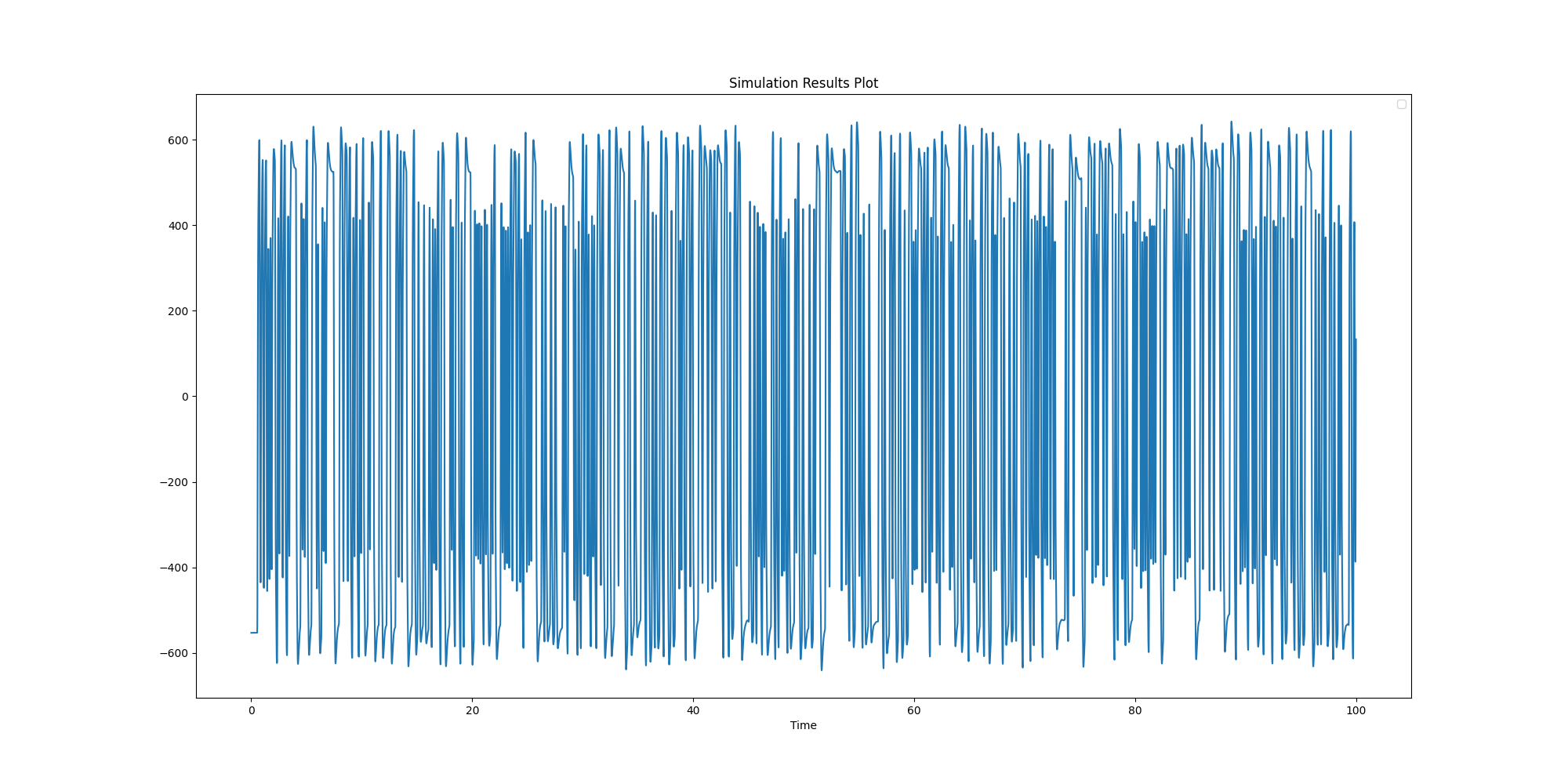
No artists with labels found to put in legend. Note that artists whose label start with an underscore are ignored when legend() is called with no argument.
Sample WaveAfterProbe waveform using receiver clock#
Extract waveform at specific clock time plus half unit interval
probe_name = "b_input_43"
source_name = "b_output4_42"
plot_type = "WaveAfterProbe"
setup_name = "AMIAnalysis"
ignore_bits = 100
unit_interval = 0.1e-9
sample_waveform = cir.post.sample_ami_waveform(setup=setup_name, probe=probe_name, source=source_name,
variation_list_w_value=cir.available_variations.nominal,
unit_interval=unit_interval, ignore_bits=ignore_bits,
plot_type=plot_type)
Plot waveform and samples#
Create the plot from a start time to stop time in seconds
tstop = 55e-9
tstart = 50e-9
scale_time = pyaedt.constants.unit_converter(1, unit_system="Time", input_units="s",
output_units=original_data.units_sweeps["Time"])
scale_data = pyaedt.constants.unit_converter(1, unit_system="Voltage", input_units="V",
output_units=original_data.units_data[plot_name])
tstop_ns = scale_time * tstop
tstart_ns = scale_time * tstart
for time in original_data_value[plot_name].index:
if tstart_ns <= time[0]:
start_index_original_data = time[0]
break
for time in original_data_value[plot_name][start_index_original_data:].index:
if time[0] >= tstop_ns:
stop_index_original_data = time[0]
break
for time in sample_waveform[0].index:
if tstart <= time:
sample_index = sample_waveform[0].index == time
start_index_waveform = sample_index.tolist().index(True)
break
for time in sample_waveform[0].index:
if time >= tstop:
sample_index = sample_waveform[0].index == time
stop_index_waveform = sample_index.tolist().index(True)
break
original_data_zoom = original_data_value[start_index_original_data:stop_index_original_data]
sampled_data_zoom = sample_waveform[0].values[start_index_waveform:stop_index_waveform] * scale_data
sampled_time_zoom = sample_waveform[0].index[start_index_waveform:stop_index_waveform] * scale_time
fig, ax = plt.subplots()
ax.plot(sampled_time_zoom, sampled_data_zoom, "r*")
ax.plot(np.array(list(original_data_zoom.index.values)), original_data_zoom.values)
ax.set_title('WaveAfterProbe')
ax.set_xlabel(original_data.units_sweeps["Time"])
ax.set_ylabel(original_data.units_data[plot_name])
plt.show()
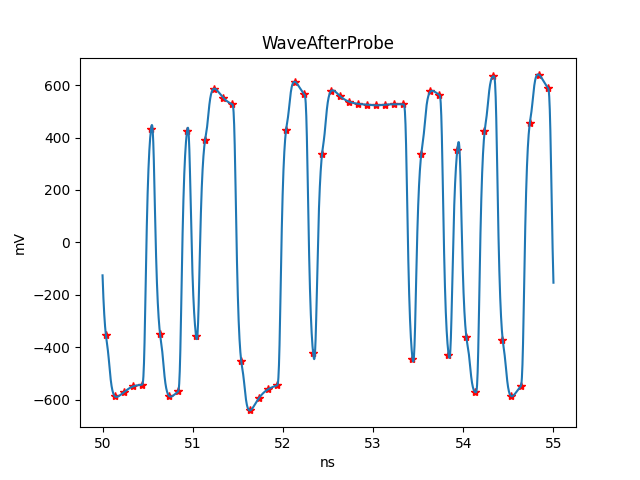
Plot Slicer Scatter#
Create the plot from a start time to stop time in seconds
fig, ax2 = plt.subplots()
ax2.plot(sample_waveform[0].index, sample_waveform[0].values, "r*")
ax2.set_title('Slicer Scatter: WaveAfterProbe')
ax2.set_xlabel("s")
ax2.set_ylabel("V")
plt.show()
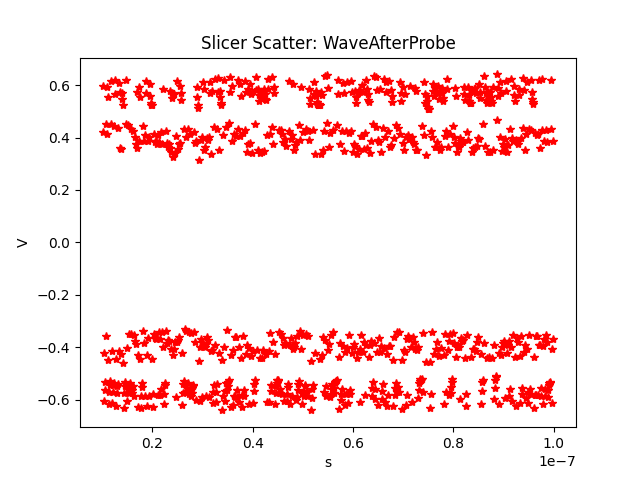
Plot scatter histogram#
Create the plot from a start time to stop time in seconds.
fig, ax4 = plt.subplots()
ax4.set_title('Slicer Histogram: WaveAfterProbe')
ax4.hist(sample_waveform[0].values, orientation='horizontal')
ax4.set_ylabel("V")
ax4.grid()
plt.show()
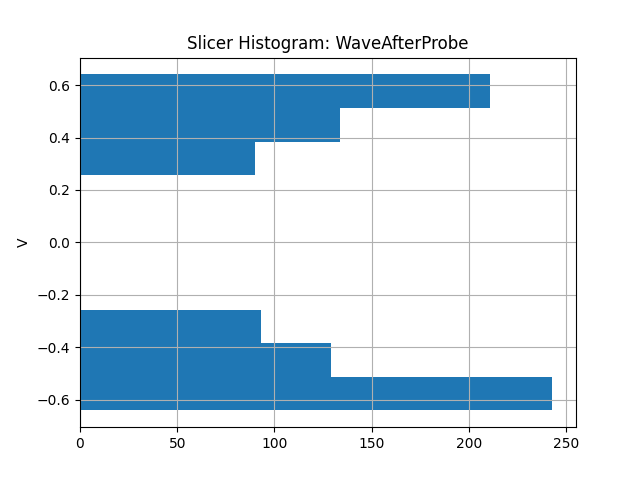
Get Transient report#
Get Transient report data
Sample waveform using a user-defined clock#
Extract waveform at specific clock time plus half unit interval.
original_data.enable_pandas_output = False
original_data_value = original_data.data_real()
original_data_sweep = original_data.primary_sweep_values
waveform_unit = original_data.units_data[plot_name]
waveform_sweep_unit = original_data.units_sweeps["Time"]
tics = np.arange(20e-9, 100e-9, 1e-10, dtype=float)
sample_waveform = cir.post.sample_waveform(
waveform_data=original_data_value,
waveform_sweep=original_data_sweep,
waveform_unit=waveform_unit,
waveform_sweep_unit=waveform_sweep_unit,
unit_interval=unit_interval,
clock_tics=tics,
pandas_enabled=False,
)
Plot waveform and samples#
Create the plot from a start time to stop time in seconds.
tstop = 40.0e-9
tstart = 25.0e-9
scale_time = pyaedt.constants.unit_converter(1, unit_system="Time", input_units="s",
output_units=waveform_sweep_unit)
scale_data = pyaedt.constants.unit_converter(1, unit_system="Voltage", input_units="V",
output_units=waveform_unit)
tstop_ns = scale_time * tstop
tstart_ns = scale_time * tstart
for time in original_data_sweep:
if tstart_ns <= time:
start_index_original_data = original_data_sweep.index(time)
break
for time in original_data_sweep[start_index_original_data:]:
if time >= tstop_ns:
stop_index_original_data = original_data_sweep.index(time)
break
cont = 0
for frame in sample_waveform:
if tstart <= frame[0]:
start_index_waveform = cont
break
cont += 1
for frame in sample_waveform[start_index_waveform:]:
if frame[0] >= tstop:
stop_index_waveform = cont
break
cont += 1
original_data_zoom = original_data_value[start_index_original_data:stop_index_original_data]
original_sweep_zoom = original_data_sweep[start_index_original_data:stop_index_original_data]
original_data_zoom_array = np.array(list(map(list, zip(original_sweep_zoom, original_data_zoom))))
original_data_zoom_array[:, 0] *= 1
sampled_data_zoom_array = np.array(sample_waveform[start_index_waveform:stop_index_waveform])
sampled_data_zoom_array[:, 0] *= scale_time
sampled_data_zoom_array[:, 1] *= scale_data
fig, ax = plt.subplots()
ax.plot(sampled_data_zoom_array[:, 0], sampled_data_zoom_array[:, 1], "r*")
ax.plot(original_sweep_zoom, original_data_zoom_array[:, 1])
ax.set_title(plot_name)
ax.set_xlabel(waveform_sweep_unit)
ax.set_ylabel(waveform_unit)
plt.show()
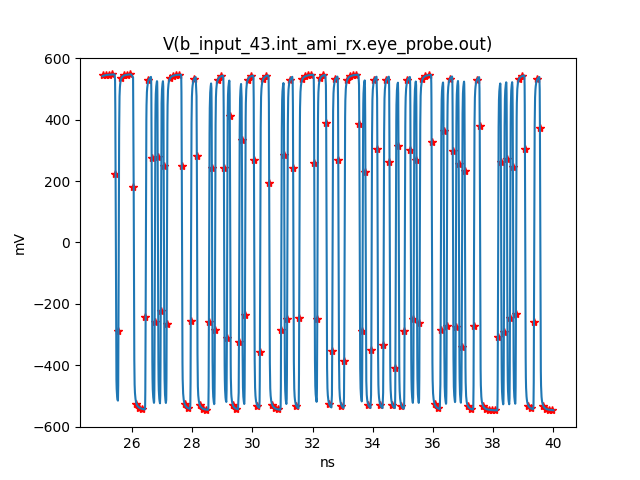
Plot slicer scatter#
Create the plot from a start time to stop time in seconds.
sample_waveform_array = np.array(sample_waveform)
fig, ax2 = plt.subplots()
ax2.plot(sample_waveform_array[:, 0], sample_waveform_array[:, 1], "r*")
ax2.set_title('Slicer Scatter: ' + plot_name)
ax2.set_xlabel("s")
ax2.set_ylabel("V")
plt.show()
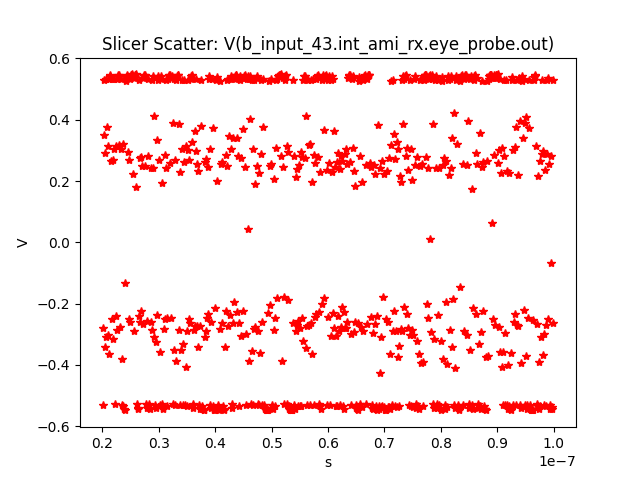
Save project and close AEDT#
Save the project and close AEDT.
cir.save_project()
print("Project Saved in {}".format(cir.project_path))
cir.release_desktop()
Project Saved in D:/Temp/pyaedt_prj_S8A/ami/
True
Total running time of the script: (1 minutes 14.302 seconds)